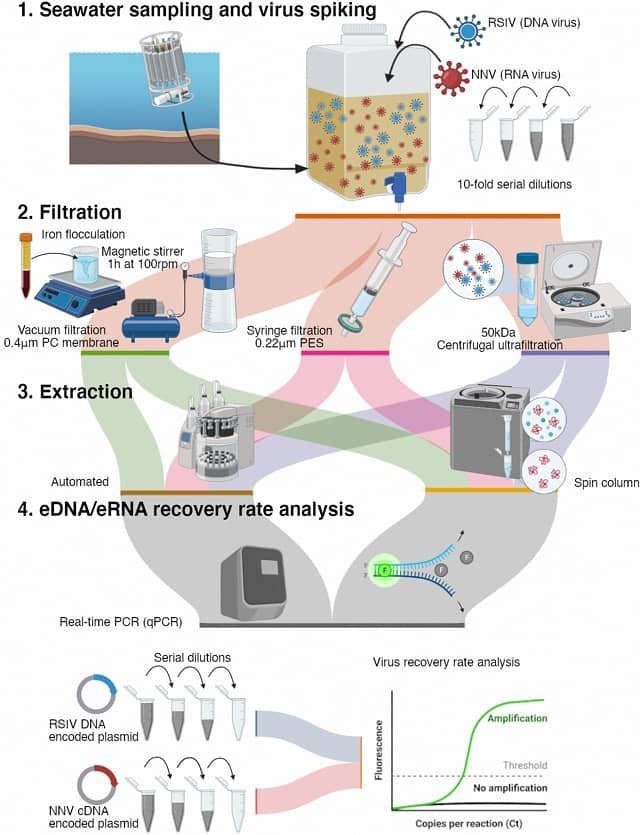
Accurate and timely detection of pathogens is crucial for the effective prevention and control of diseases in the aquaculture industry. Traditional methods often involve sacrificing fish to obtain samples for diagnostic testing, which can be ethically challenging and time-consuming.
To address these limitations, researchers have explored non-invasive approaches, such as monitoring waterborne pathogens. Researchers at the Norwegian Veterinary Institute tested different filtration methods with freshwater and seawater for a panel of fish pathogens to determine a suitable procedure for application in fish farms.
The researchers focused on five major pathogens affecting Atlantic salmon in Norwegian aquaculture: salmonid alphavirus (SAV), infectious salmon anemia virus (ISAV), piscine orthoreovirus (PRV), salmon gill poxvirus (SGPV), and Yersinia ruckeri.
Traditional Methods Are Not Enough
Traditional disease surveillance methods in salmon farming often rely on sampling fish for laboratory analysis. While this approach can provide valuable information, it has several limitations. First, it can be time- and labor-intensive, delaying the implementation of preventive measures. Second, it can be invasive and potentially harmful to the fish. Lastly, traditional methods may not be sensitive enough to detect pathogens at low levels, especially during the early stages of an outbreak.
The Promise of eDNA Sampling
Environmental DNA (eDNA) sampling offers a promising alternative to traditional methods for monitoring fish diseases. By collecting and analyzing water samples, eDNA can be used to detect the presence of various organisms, including pathogens.
This non-invasive approach has gained popularity in recent years due to its potential to provide early warnings of disease outbreaks and monitor pathogen spread, along with other benefits:
- Early detection: eDNA can detect pathogens at low levels, allowing for early intervention and disease outbreak prevention.
- Animal welfare: It avoids the need to sacrifice fish for testing, reducing animal suffering.
- Cost-effectiveness: eDNA sampling can be more cost-effective than traditional methods.
Filtration Methods for Pathogen Detection
Filtration of water samples followed by molecular detection of target pathogens offers a promising alternative to traditional methods. This approach involves capturing pathogens from the water using filters and then analyzing the captured material for the presence of specific DNA or RNA sequences. However, the choice of filtration method can significantly affect pathogen detection efficiency.
A New “Sandwich” Filtration Method
The study published in PLOS ONE evaluated several filtration methods to determine their suitability for detecting a variety of fish pathogens in both freshwater and seawater. The researchers tested different combinations of filtration flow rates, lysis buffers, and filters to identify the optimal approach for in-situ application by farm staff.
Stay Always Informed
Join our communities to instantly receive the most important news, reports, and analysis from the aquaculture industry.
The results showed that a “sandwich” filtration method, which uses two distinct filters, provided the best performance. This method involved passing the water through a hydrophilic glass fiber filter with binder resin followed by a hydrophilic mixed cellulose ester membrane. This combination effectively concentrated viral and bacterial pathogens, allowing their reliable detection through quantitative polymerase chain reaction (qPCR).
Importance and Implications
The development of this new filtration method represents a significant advancement in fish pathogen detection and surveillance. By enabling the simultaneous detection of a variety of pathogens in a single filtration step, this approach can streamline the diagnostic process and reduce analysis costs. Additionally, the simplicity and ease of use of the method make it ideal for in-situ application by aquaculture farm staff.
Key Advantages of the Sandwich Filtration Method:
- Efficiency: The sandwich filtration method efficiently captures a wide range of fish pathogens, including viruses and bacteria, from water samples.
- Simplicity: The method is relatively straightforward and can be easily implemented on-site by farm staff with minimal training.
- Cost-effectiveness: By combining the filtration and nucleic acid extraction steps into a single process, the sandwich method reduces costs and analysis time.
- Sensitivity: The method offers high sensitivity for pathogen detection, enabling early identification and intervention.
Conclusion
eDNA sampling represents a significant advancement in fish disease surveillance. The protocol developed in this study provides a practical and effective tool for detecting a wide range of pathogens in aquaculture environments.
In this regard, the development of the sandwich filtration method represents a significant breakthrough in fish pathogen detection for aquaculture. This innovative approach provides a non-invasive, efficient, and cost-effective tool for monitoring waterborne pathogens and preventing disease outbreaks. By adopting this technology, aquaculture producers can improve fish health, reduce economic losses, and promote sustainable practices.
Contact
Ottavia Benedicenti
Norwegian Veterinary Institute
Ås, Norway
Email: ottavia.benedicenti@vetinst.no
Reference (open access)
Benedicenti O, Måsøy Amundsen M, Mohammad SN, Vrålstad T, Strand DA, Weli SC, et al. (2024) A refinement to eRNA and eDNA-based detection methods for reliable and cost-efficient screening of pathogens in Atlantic salmon aquaculture. PLoS ONE 19(10): e0312337. https://doi.org/10.1371/journal.pone.0312337
Editor at the digital magazine AquaHoy. He holds a degree in Aquaculture Biology from the National University of Santa (UNS) and a Master’s degree in Science and Innovation Management from the Polytechnic University of Valencia, with postgraduate diplomas in Business Innovation and Innovation Management. He possesses extensive experience in the aquaculture and fisheries sector, having led the Fisheries Innovation Unit of the National Program for Innovation in Fisheries and Aquaculture (PNIPA). He has served as a senior consultant in technology watch, an innovation project formulator and advisor, and a lecturer at UNS. He is a member of the Peruvian College of Biologists and was recognized by the World Aquaculture Society (WAS) in 2016 for his contribution to aquaculture.




